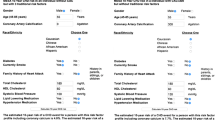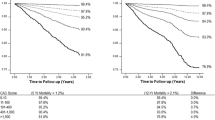Abstract
Cardiovascular disease is the leading cause of death in the United States. Identifying individuals at risk for cardiovascular events facilitates the earlier initiation of preventive therapies of at-risk individuals. While many risk scores and algorithms aimed at identifying individuals at increased risk for events are commonly used in clinical practice, their ability to correctly identify individuals who will experience a cardiovascular event is limited. Coronary artery calcium scoring is a noninvasive method of quantifying the burden of coronary atherosclerosis and has been demonstrated to improve the risk prediction of individuals above and beyond traditional risk factors.
Similar content being viewed by others
References
Papers of particular interest, published recently, have been highlighted as: • Of importance ••Of major importance
Lloyd-Jones D, Adams R, Carnethon M, et al.: Heart disease and stroke statistics--2009 update: a report from the American Heart Association Statistics Committee and Stroke Statistics Subcommittee. Circulation 2009, 119:480–486.
World Health Organization: Cardiovascular Disease Report Fact sheet. Geneva: World Health Organization; 2009.
Wilson PW, D’Agostino RB, Levy D, et al.: Prediction of coronary heart disease using risk factor categories. Circulation 1998, 97:1837–1847.
Ridker PM, Buring JE, Rifai N, Cook NR: Development and validation of improved algorithms for the assessment of global cardiovascular risk in women: the Reynolds Risk Score. JAMA 2007, 297:611–619.
Hippisley-Cox J, Coupland C, Vinogradova Y, et al.: Derivation and validation of QRISK, a new cardiovascular disease risk score for the United Kingdom: prospective open cohort study. BMJ 2007, 335:136.
Akosah KO, Schaper A, Cogbill C, Schoenfeld P: Preventing myocardial infarction in the young adult in the first place: how do the National Cholesterol Education Panel III guidelines perform? J Am Coll Cardiol 2003, 41:1475–1479.
Michos ED, Nasir K, Braunstein JB, et al.: Framingham risk equation underestimates subclinical atherosclerosis risk in asymptomatic women. Atherosclerosis 2006, 184:201–206.
Rumberger JA, Simons DB, Fitzpatrick LA, et al.: Coronary artery calcium area by electron-beam computed tomography and coronary atherosclerotic plaque area. A histopathologic correlative study. Circulation 1995, 92:2157–2162.
Shaw LJ, Raggi P, Schisterman E, et al.: Prognostic value of cardiac risk factors and coronary artery calcium screening for all-cause mortality. Radiology 2003, 228:826–833.
Kondos GT, Hoff JA, Sevrukov A, et al.: Electron-beam tomography coronary artery calcium and cardiac events: a 37-month follow-up of 5635 initially asymptomatic low- to intermediate-risk adults. Circulation 2003, 107:2571–2576.
Greenland P, LaBree L, Azen SP, et al.: Coronary artery calcium score combined with Framingham score for risk prediction in asymptomatic individuals. JAMA 2004, 291:210–215.
Arad Y, Goodman KJ, Roth M, et al.: Coronary calcification, coronary disease risk factors, C-reactive protein, and atherosclerotic cardiovascular disease events: the St. Francis Heart Study. J Am Coll Cardiol 2005, 46:158–165.
LaMonte MJ, FitzGerald SJ, Church TS, et al.: Coronary artery calcium score and coronary heart disease events in a large cohort of asymptomatic men and women. Am J Epidemiol 2005, 162:421–429.
Taylor AJ, Bindeman J, Feuerstein I, et al.: Coronary calcium independently predicts incident premature coronary heart disease over measured cardiovascular risk factors: mean three-year outcomes in the Prospective Army Coronary Calcium (PACC) project. J Am Coll Cardiol 2005, 46:807–814.
Budoff MJ, Shaw LJ, Liu ST, et al.: Long-term prognosis associated with coronary calcification: observations from a registry of 25,253 patients. J Am Coll Cardiol 2007, 49:1860–1870.
Becker A, Leber A, Becker C, Knez A: Predictive value of coronary calcifications for future cardiac events in asymptomatic individuals. Am Heart J 2008, 155:154–160.
•• Detrano R, Guerci A, Carr J, et al.: Coronary calcium as a predictor of coronary events in four racial or ethnic groups. N Engl J Med 2008, 358:1336. This important article demonstrates that calcium scoring improves risk prediction beyond traditional risk factors in different racial and ethnic groups.
• Raggi P, Gongora MC, Gopal A, et al.: Coronary artery calcium to predict all-cause mortality in elderly men and women. J Am Coll Cardiol 2008, 52:17–23. This article demonstrates that calcium scoring discriminates mortality risk in a large cohort of older subjects
•• Polonsky TS, McClelland RL, Jorgensen NW, et al.: Coronary artery calcium score and risk classification for coronary heart disease prediction. JAMA 2010, 303:1610–1616. This article describes the net reclassification improvement of calcium scoring in a multi-ethnic cohort.
Erbel R MS, Moebus S, et al.: Signs of subclinical coronary atherosclerosis measured as coronary artery calcification improve risk prediction of hard events beyond traditional risk factors in an unselected general population: The Heinz Nixdorf Recall Study five-year outcome data. Presented at the ACC Annual Scientific Session. Orlando, FL; 2009.
Vliegenthart R, Oudkerk M, Hofman A, et al.: Coronary calcification improves cardiovascular risk prediction in the elderly. Circulation 2005, 112:572–577.
Nasir K, Shaw LJ, Liu ST, et al.: Ethnic differences in the prognostic value of coronary artery calcification for all-cause mortality. J Am Coll Cardiol 2007, 50:953–960.
Rozanski A, Gransar H, Wong ND, et al.: Clinical outcomes after both coronary calcium scanning and exercise myocardial perfusion scintigraphy. J Am Coll Cardiol 2007, 49:1352–1361.
• Greenland P, Bonow RO, Brundage BH, et al.: ACCF/AHA 2007 clinical expert consensus document on coronary artery calcium scoring by computed tomography in global cardiovascular risk assessment and in evaluation of patients with chest pain: a report of the American College of Cardiology Foundation Clinical Expert Consensus Task Force (ACCF/AHA Writing Committee to Update the 2000 Expert Consensus Document on Electron Beam Computed Tomography) developed in collaboration with the Society of Atherosclerosis Imaging and Prevention and the Society of Cardiovascular Computed Tomography. J Am Coll Cardiol 2007, 49:378–402. These are the official consensus guidelines on CAC scoring from the American Heart Association and American College of Cardiology Foundation.
Agatston AS, Janowitz WR, Hildner FJ, et al.: Quantification of coronary artery calcium using ultrafast computed tomography. J Am Coll Cardiol 1990, 15:827–832.
Qian Z, Marvasty I, Akram K, et al.: Lesion- and vessel-specific coronary artery calcium scores are superior to whole-heart Agatston and volume scores in the diagnosis of obstructive coronary artery disease. J Cardiovasc Comput Tomogr 2010, In press.
Detrano RC, Wong ND, Doherty TM, et al.: Coronary calcium does not accurately predict near-term future coronary events in high-risk adults. Circulation 1999, 99:2633–2638.
Park R, Detrano R, Xiang M, et al.: Combined use of computed tomography coronary calcium scores and C-reactive protein levels in predicting cardiovascular events in nondiabetic individuals. Circulation 2002, 106:2073–2077.
Georgiou D, Budoff MJ, Kaufer E, et al.: Screening patients with chest pain in the emergency department using electron beam tomography: a follow-up study. J Am Coll Cardiol 2001, 38:105–110.
Margolis JR, Chen JT, Kong Y, et al.: The diagnostic and prognostic significance of coronary artery calcification. A report of 800 cases. Radiology 1980, 137:609–616.
Detrano R, Hsiai T, Wang S, et al.: Prognostic value of coronary calcification and angiographic stenoses in patients undergoing coronary angiography. J Am Coll Cardiol 1996, 27:285–290.
Möhlenkamp S, Lehmann N, Schmermund A, et al.: Prognostic value of extensive coronary calcium quantities in symptomatic males—a 5-year follow-up study. Eur Heart J 2003, 24:845–854.
Schmermund A, Stang A, Mohlenkamp S, et al.: Prognostic value of electron-beam computed tomography-derived coronary calcium scores compared with clinical parameters in patients evaluated for coronary artery disease. Prognostic value of EBCT in symptomatic patients. Z Kardiol 2004, 93:696–705.
Becker A, Knez A, Becker C, et al.: Prediction of serious cardiovascular events by determining coronary artery calcification measured by multi-slice computed tomography. Dtsch Med Wochenschr 2005, 130:2433–2438.
Keelan PC, Bielak LF, Ashai K, et al.: Long-term prognostic value of coronary calcification detected by electron-beam computed tomography in patients undergoing coronary angiography. Circulation 2001, 104:412–417.
Schenker MP, Dorbala S, Hong EC, et al.: Interrelation of coronary calcification, myocardial ischemia, and outcomes in patients with intermediate likelihood of coronary artery disease: a combined positron emission tomography/computed tomography study. Circulation 2008, 117:1693–1700.
Laudon DA, Behrenbeck TR, Wood CM, et al.: Computed tomographic coronary artery calcium assessment for evaluating chest pain in the emergency department: long-term outcome of a prospective blind study. Mayo Clin Proc 2010, 85:314–322.
McLaughlin VV, Balogh T, Rich S: Utility of electron beam computed tomography to stratify patients presenting to the emergency room with chest pain. Am J Cardiol 1999, 84:327–328, A8.
Budoff MJ, Raggi P: Coronary artery disease progression assessed by electron-beam computed tomography. Am J Cardiol 2001, 88:46E–50E.
Yoon HC, Emerick AM, Hill JA, et al.: Calcium begets calcium: progression of coronary artery calcification in asymptomatic subjects. Radiology 2002, 224:236–241.
Cassidy AE, Bielak LF, Zhou Y, et al.: Progression of subclinical coronary atherosclerosis: does obesity make a difference? Circulation 2005, 111:1877–1882.
Kronmal RA, McClelland RL, Detrano R, et al.: Risk factors for the progression of coronary artery calcification in asymptomatic subjects: results from the Multi-Ethnic Study of Atherosclerosis (MESA). Circulation 2007, 115:2722–2730.
Raggi P, Cooil B, Shaw LJ, et al.: Progression of coronary calcium on serial electron beam tomographic scanning is greater in patients with future myocardial infarction. Am J Cardiol 2003, 92:827–829.
Raggi P, Callister TQ, Shaw LJ: Progression of coronary artery calcium and risk of first myocardial infarction in patients receiving cholesterol-lowering therapy. Arterioscler Thromb Vasc Biol 2004, 24:1272–1277.
Shareghi S, Ahmadi N, Young E, et al.: Prognostic significance of zero coronary calcium scores on cardiac computed tomography. J Cardiovasc Comput Tomogr 2007, 1:155–159.
• Blaha M, Budoff MJ, Shaw LJ, et al.: Absence of coronary artery calcification and all-cause mortality. JCMG 2009, 2:692–700. Using data from a large cohort, the authors demonstrated that absence of calcium is associated with a very low risk of all-cause mortality.
Sarwar A, Shaw LJ, Shapiro MD, et al.: Diagnostic and prognostic value of absence of coronary artery calcification. JACC Cardiovasc Imaging 2009, 2:675–688.
Henneman MM, Schuijf JD, Pundziute G, et al.: Noninvasive evaluation with multislice computed tomography in suspected acute coronary syndrome: plaque morphology on multislice computed tomography versus coronary calcium score. J Am Coll Cardiol 2008, 52:216–222.
Akram K, O’Donnell RE, King S, et al.: Influence of symptomatic status on the prevalence of obstructive coronary artery disease in patients with zero calcium score. Atherosclerosis 2009, 203:533–537.
Kim KP, Einstein AJ, Berrington de Gonzalez A: Coronary artery calcification screening: estimated radiation dose and cancer risk. Arch Intern Med 2009, 169:1188–1194.
Shaw LJ, Min JK, Budoff M, et al.: Induced cardiovascular procedural costs and resource consumption patterns after coronary artery calcium screening: results from the EISNER (Early Identification of Subclinical Atherosclerosis by Noninvasive Imaging Research) study. J Am Coll Cardiol 2009, 54:1258–1267.
Diamond GA, Kaul S: The things to come of SHAPE: cost and effectiveness of cardiovascular prevention. Am J Cardiol 2007, 99:1013–1015.
Using nontraditional risk factors in coronary heart disease risk assessment: U.S. Preventive Services Task Force recommendation statement. Ann Intern Med 2009, 151:474–482.
Acknowledgment
Dr. Rubin was supported by National Heart, Lung, and Blood Institute grant 5T32HL007024.
Disclosure
No potential conflicts of interest relevant to this article were reported.
Author information
Authors and Affiliations
Corresponding author
Rights and permissions
About this article
Cite this article
Rubin, J., Nasir, K., Agatston, A.S. et al. Coronary Arterial Calcium and Outcomes. Curr Cardiovasc Imaging Rep 3, 342–349 (2010). https://doi.org/10.1007/s12410-010-9049-1
Published:
Issue Date:
DOI: https://doi.org/10.1007/s12410-010-9049-1




